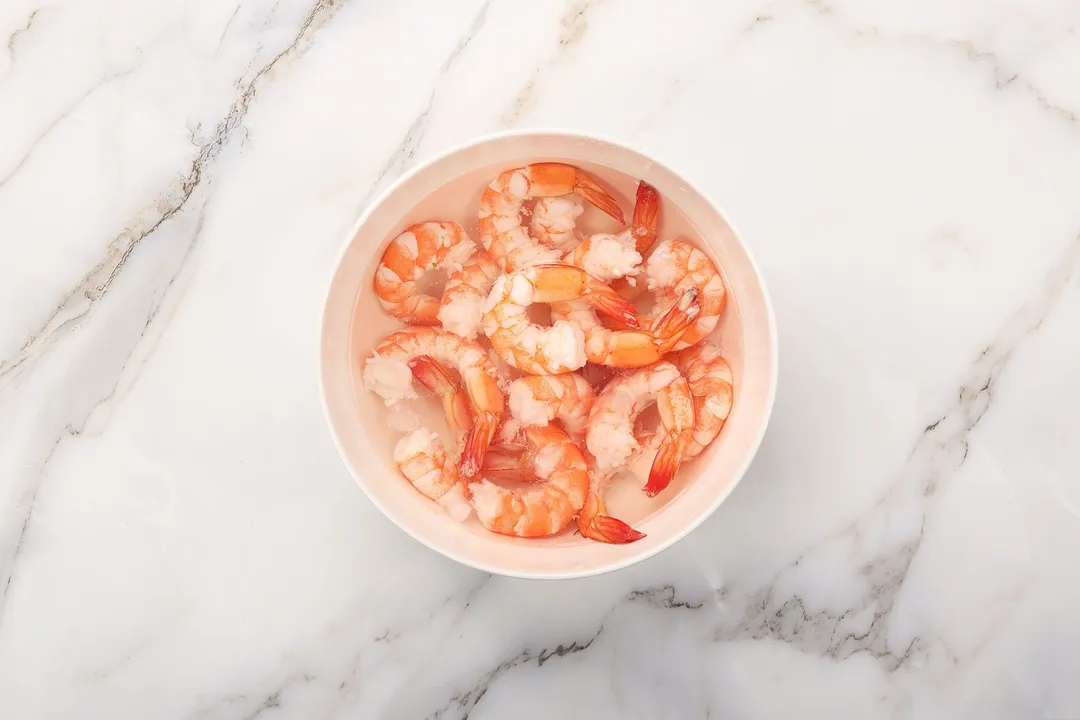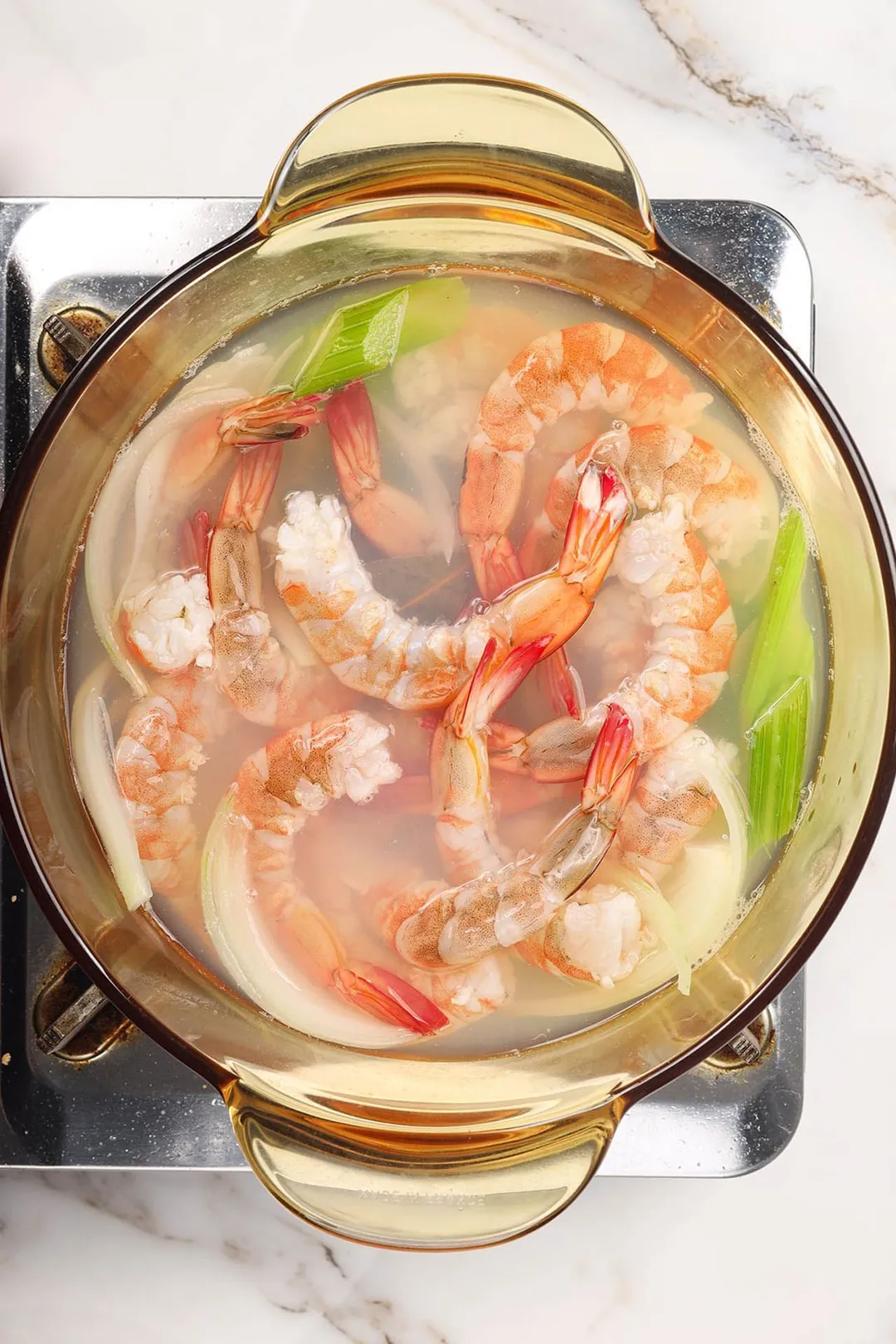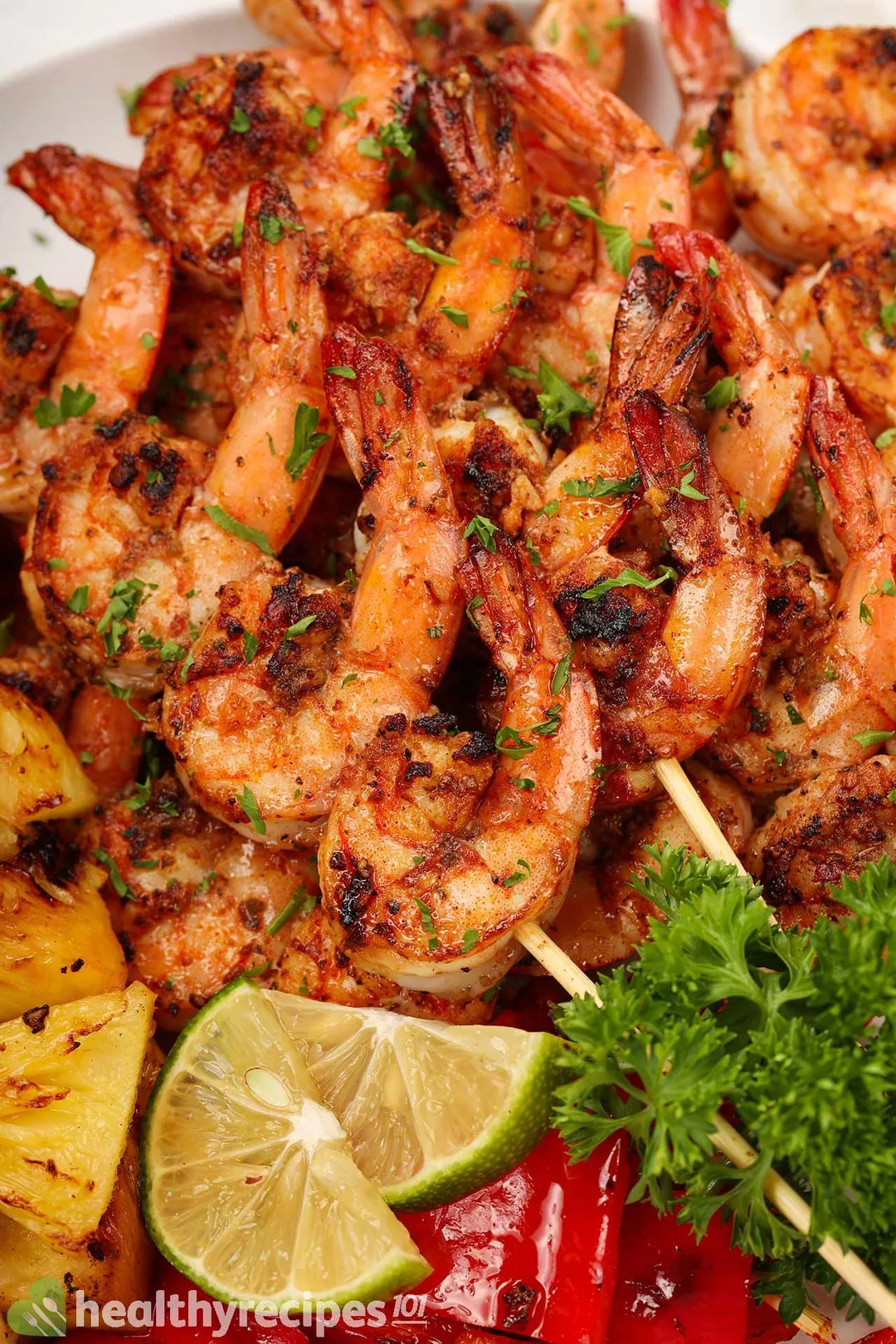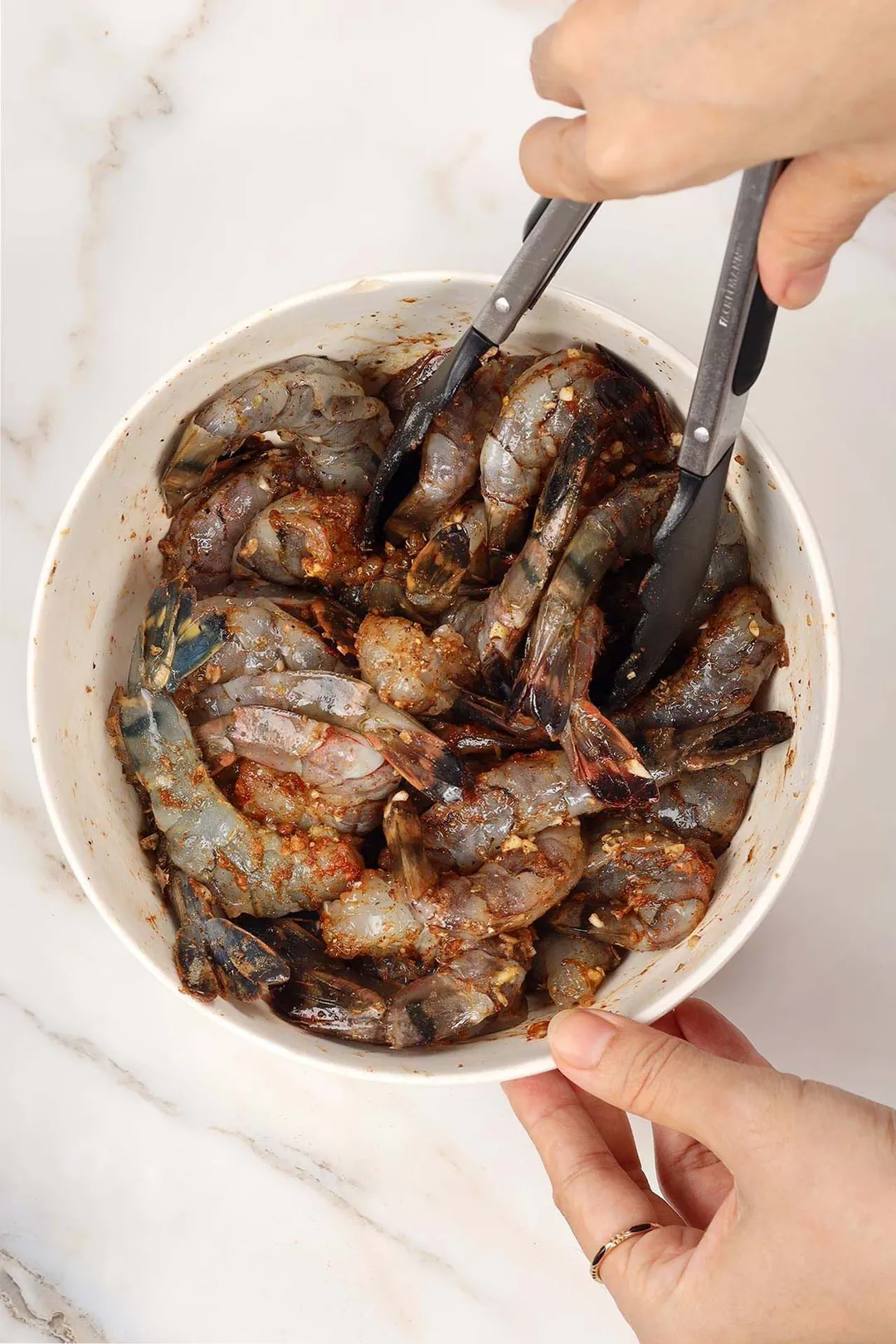Today’s topic is about how long to boil shrimp.
It may sound like a simple task, but that doesn’t mean you should take it easy. While it usually takes less than 5 minutes to cook, it’s a meticulous process that requires all of your attention.
So, if you’ve ever experienced rubbery or tasteless boiled shrimp, you may want to stick around and check out this article.
Before we start cooking, here are some queries you may have been wondering about:
Do You Peel Shrimp Before Boiling?
You can, but we wouldn’t recommend it.
Peeled shrimp may be convenient as it’s easier to remove their veins and they're ready to eat once cooked but they tend to lack texture and flavor without the shells to protect the meat.
You may have seen recipes tell you to save shrimp heads and shells and use them to make a stock or broth. That’s because those exoskeletons add an interesting sweet and briny flavor to the stock.

It also explains why the exquisite taste of unpeeled cooked shrimp, regardless of the cooking method. In addition, the shells act as a shield - protecting the meat, keeping it juicy, and stopping it from getting rubbery.
So, our suggestion would be not to peel the shrimp.
How to Devein Shell-On Shrimp
Another thing you should know about fresh whole shrimp is the need to clean them properly before cooking, from peeling to removing the vein.
Shell-on shrimp are a bit trickier to get to the vein. Fortunately, we have two easy methods you can try.
Method #1: The Toothpick
- Twist and remove the shrimp heads.
- Look at the back of a shrimp and examine its shell. You should be able to identify the segments.
- Pry between the first and second segments.
- Slide a toothpick in between the segments.
- Lift the toothpick and you should be able to remove the whole vein.
- Repeat with the remaining shrimp.
Method #2: The Slit
- Once the shrimp heads are removed, use a pair of kitchen scissors to cut through the shells on the back of a shrimp, creating a slit.
- You should be able to see the black vein that runs from the head end to the tail end.
- Use a paring knife to help you reach the vein and take it out.
- Repeat the same process with all of the shrimp.
How Long Do You Boil Shrimp?
The cooking time for boiled shrimp depends on the size and temperature of the shrimp, as well as the cooking method.
For today’s article on how long to boil shrimp, we’re putting fresh and frozen shrimp to the test.
1. Fresh Raw Shrimp
Here’s how we boil raw shrimp:
- Clean the shrimp as instructed. If your shrimp are frozen, allow them to thaw in the refrigerator overnight.
- Prepare an ice bath by filling a large bowl halfway with ice and water. Set it aside.
- Bring a pot of water to a boil. (We recommend using 4 quarts of water for a 6-quart pot.)
- Add 10 oz of shrimp to the boiling water and give it a stir. The shrimp should have room to float around. (If you have more than 10 oz, divide and cook the shrimp in batches.)
- Wait for the water to come back to a boil.
- Turn off the heat right when you see the water start to boil.
- Remove the shrimp from the hot water using a strainer or dump the whole pot into a colander in the sink.
- Put the shrimp into the ice bath immediately to stop the cooking process.
- Drain the shrimp from the iced water and they’re ready to serve.
The time it takes to come back to a boil is the same time it takes for the shrimp to cook:
- How long to boil jumbo shrimp (21/25 count per lb.): 2 to 2.5 minutes.
- How long to boil extra-large shrimp (26/30 count): 1.5 to 2 minutes.
- How long to boil medium shrimp (41/50 count): 1 to 1.5 minutes.
2. Frozen Shrimp
Boiling frozen shrimp is a bit different from raw shrimp. Here’s how you do it:
- Likewise, clean the shrimp and prepare an ice bath.
- Put the frozen shrimp into a medium pot. Make sure the shrimp only fill one-third of the pot.
- Fill the pot with regular tap water until it reaches two-thirds full. (Don’t use hot water.)
- Cover and bring the pot to a boil over high heat. It may take 5 to 7 minutes.
- Once it starts boiling, turn off the heat immediately and drain the cooking water.
- Transfer the cooked shrimp to the ice bath to stop the cooking process. After that, drain the shrimp and serve.
This cooking method allows the frozen shrimp to come up to temperature with the water. This ensures that the shrimp are cooked evenly inside and outside.
3. How to Boil Shrimp for Shrimp Cocktail
Shrimp cocktail is a popular cold finger food that is often served at parties. The perfectly cooked shrimp taste delightfully fresh and crunchy and are served with a flavorful dipping sauce. It’s the ultimate crowd pleaser.

Since freshness is the highlight of this dish, we highly recommend using fresh raw extra-jumbo or jumbo shrimp. Here’s how to cook them for shrimp cocktail:
- Similarly, clean the shrimp and prepare an ice bath.
- Bring a pot of water to a boil over high heat. At this point, you can spice up the water with lemon juice or lemon slices, and peppercorns, along with your favorite herbs and aromatics such as thyme, parsley, dill, etc.
- Add shrimp to the boiling water. Wait for the water to come back to a boil.
- Turn off the heat and drain the shrimp as the water starts to boil. Discard the aromatics.
- Put the drained shrimp into the ice bath. Once the shrimp are cool, drain again.
- Put the shrimp in an airtight container and chill them in the fridge for at least 2 hours prior to serving.
- To serve, plate the shrimp with your favorite cocktail sauce.
Remember: if you're boiling jumbo shrimp it should take 2 to 2.5 minutes for jumbo shrimp, and 2.5 to 3 minutes for extra-jumbo shrimp.
4. How to Tell If Shrimp Are Cooked
Visually, you can tell the shrimp are cooked when they turn from a gray or blue-ish color to pink and opaque.
If you want to be extra careful and check the internal temperature, here’s how you do it:
- When the shrimp start to boil, turn off the heat.
- Carefully use a pair of tongs to fish out a shrimp from the hot water. Place it on a clean cutting board.
- Gently use the tongs to hold the shrimp down in place while inserting a food thermometer into the head end of the shrimp. If the thermometer reads 145 °F internal temperature, the shrimp are cooked.
- Drain the pot of shrimp and put them into an ice bath to stop the cooking process.
Doing so will ensure that your shrimp are safe to eat regardless of your cooking method. And, you get to snack on the test piece afterward!
FAQ
Here are some commonly asked questions when it comes to boiling shrimp:
How Long to Boil Shrimp with and without the Shell
You may not believe it, but whether the shell has been removed or not, it is so thin that it doesn’t affect the cooking time. It all depends on the size of the shrimp.
Best Shrimp Size for Boiling
Any size of shrimp can be used for boiling. That being said, our top picks would have to be shell-on, fresh extra-jumbo, and jumbo shrimp.
These bigger shrimp have an interesting crunch once they’re boiled. They also have a subtly sweet and enjoyably juicy flavor. And, the meatier the shrimp are, the more you get to savor that sensational taste.

- TiboiyaHelpful guide for perfectly boiled shrimp preparation.

